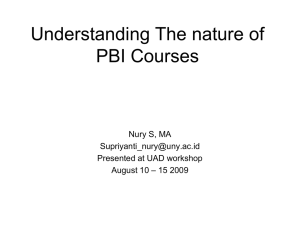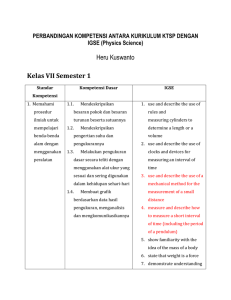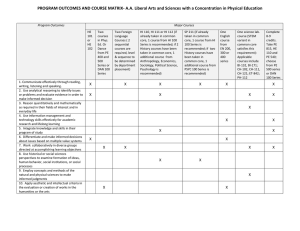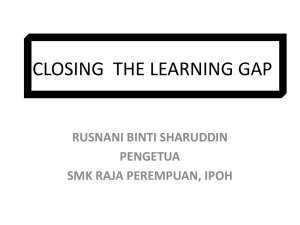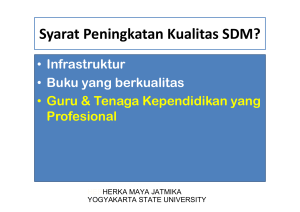ENGLISH FOR VOCATIONAL EDUCATION
advertisement
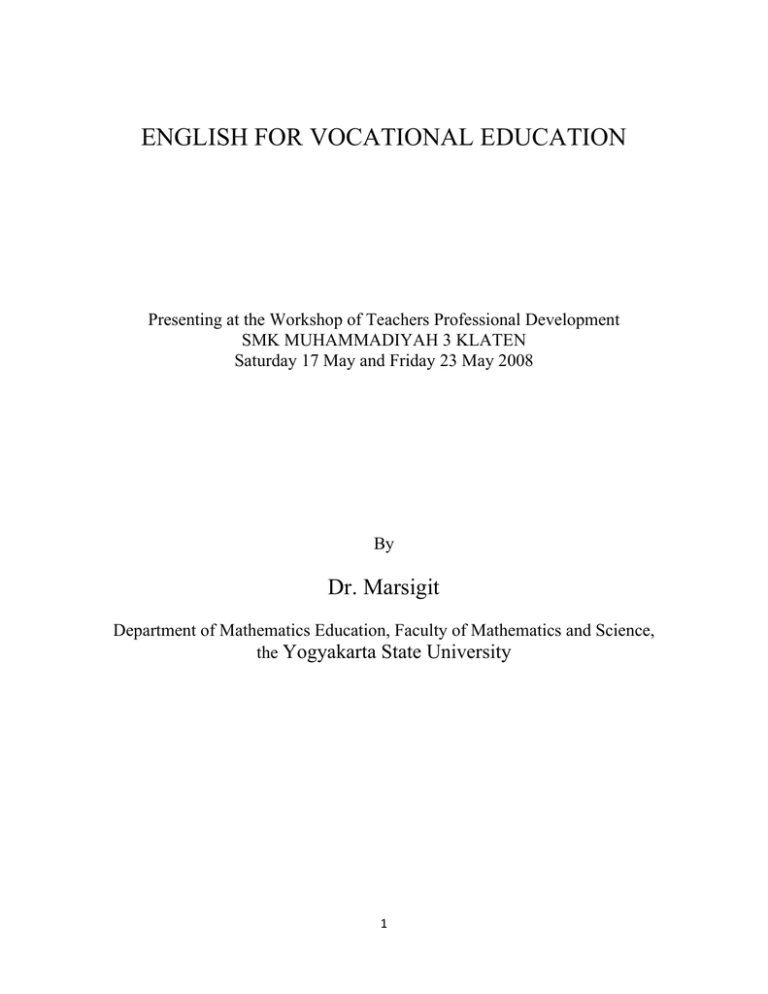
ENGLISH FOR VOCATIONAL EDUCATION Presenting at the Workshop of Teachers Professional Development SMK MUHAMMADIYAH 3 KLATEN Saturday 17 May and Friday 23 May 2008 By Dr. Marsigit Department of Mathematics Education, Faculty of Mathematics and Science, the Yogyakarta State University 1 A. Introduction Vocational education, sometimes called Career and Technical Education (CTE)) has its aim to prepare learners for careers that are based in manual or practical activities, occupation or vocation, hence the term, in which the learner participates. It is sometimes referred to as technical education, as the learner directly develops expertise in a particular group of techniques or technology. Vocational education might be contrasted with education in a usually broader scientific field, which might concentrate on theory and abstract conceptual knowledge, characteristic of tertiary education. While, vocational education can be at the secondary or postsecondary level and can interact with the apprenticeship system. In Indonesia, vocational education be recognised in secondary program of education that is SMK ( Sekolah Menengah kejuruan). In order to meet the labor market that is to becomes more specialized and economies demand higher levels of skill, government of Indonesia (GOI) increasingly encouraging and investing in the future of vocational education through publicly funded training organizations and subsidized apprenticeship or traineeship initiatives for businesses; including the establishing SBI (Sekolah Bertaraf Internasional). In order to perform international standard, such kind of SBI needs to be supported by qualified and professional teaching staffs, facilities and good management. The school as well as its academic staffs should also to be able to perform the relevance of programs, its efficiency, its effectiveness, its accountability and to sustain the program. For those kinds of reason it is obliged for SMK teachers to be able to communicate their vocational knowledge, skills and experiences in English. The aim of this paper is to introduce and develop the extent the teachers employ English as a language to communicate vocational education, covers: basic knowledge of English, describing objects related to vocational education, preparing vocational teaching in English, and teaching learning process of vocational subject matter in English. B. The Need of English The key factor of the success of teaching learning process is communication. The frameworks for a series of interactive English-mediated tasks which encourages teachers to meet both curriculum requirements and the learning needs as well as the interests of their own students. In term of teaching learning process, teachers are able to employ English to complete the task of teaching, to introduce and learn technology, to encourage the students to communicate their results of learning, to achieve the objective of learning, and to develop teaching learning resources. The teacher needs to appropriately use English-mediated interactions as a basis for expanded classroom interaction and develop the attitude with their students to this use of English. Followings are the recommendations should perform when English is to be used as languagebased teaching learning process: 1. Developing Curriculum in English 2 2. Developing Syllabi in English 3. Developing Teaching Content in English 4. Developing Lesson-Plan in English 5. Developing Student Works Sheet in English 6. Developing Evaluation system or assessment in English 7. Conducting whole-class teaching in English 8. Various interaction in English 9. Various method of teaching in English 10. Various media of teaching in English 11. Group-discussion in English 12. Facilitate student learning in English 13. Presenting the results of discussion in English C. How to Develop English for Vocational Education 1. Preparing English for Teaching Example of Study Page: 3 4 2. Developing Curriculum in English Competency-Based Education focuses on the outcomes or outputs of learning not on the inputs to learning. English language teaching syllabus designed based on CBE does not focus on subject knowledge of English and skills constituting that knowledge but on competencies or learning outcomes underlying the syllabus framework, that is, on how well the learners can perform on specific learning skills (Sumartono, E.S. 2007). Competencies here reflect the description of skills, knowledge, attitudes, and behaviors required for effective performance of a real world task or activity which should be related to cultural and tourism development. The present condition in Indonesia “KTSP” or competency-based standard in curriculum is decentralized autonomy to provincies or regions. Exercise 1: Translate the following into English Mata Pelajaran Keterampilan Komputer dan Pengelolaan Informasi untuk Sekolah Menengah Kejuruan (SMK)/Madrasah Aliyah Kejuruan (MAK) A. Latar Belakang Teknologi informasi dan komunikasi berkembang pesat, dipicu oleh temuan dalam bidang rekayasa material mikroelektronika. Perkembangan ini berpengaruh besar terhadap berbagai aspek kehidupan, bahkan perilaku dan aktivitas manusia banyak bergantung pada teknologi informasi dan komunikasi. Mata pelajaran KKPI dimaksudkan untuk mempersiapkan peserta didik agar mampu mengantisipasi pesatnya perkembangan tersebut. Mata pelajaran KKPI perlu diperkenalkan, dipraktikkan dan dikuasai peserta didik sedini mungkin agar mereka memiliki bekal untuk menyesuaikan diri dalam kehidupan global. Untuk menghadapinya diperlukan kemampuan dan kemauan belajar sepanjang hayat dengan cepat dan cerdas. Hasil‐hasil teknologi informasi dan komunikasi banyak membantu manusia untuk dapat belajar secara cepat. Dengan demikian selain sebagai bagian dari kehidupan sehari‐hari, teknologi informasi dan komunikasi dapat dimanfaatkan untuk merevitalisasi proses belajar yang pada akhirnya dapat mengadaptasikan peserta didik dengan lingkungannya dan dunia kerja. Mata pelajaran KKPI membekali peserta didik untuk beradaptasi dengan dunia kerja dan perkembangan dunia, juga pendidikan pada jenjang yang lebih tinggi. Mata pelajaran KKPI diajarkan untuk mendukung pembentukan kompetensi program keahlian serta memudahkan peserta didik mendapatkan pekerjaan yang berskala nasional maupun internasional. B. Tujuan Mata pelajaran KKPI bertujuan agar peserta didik memiliki kemampuan sebagai berikut. 1. Menggunakan teknologi komputer dalam kehidupan sehari‐hari 2. Mengaplikasikan komputer sesuai dengan standar kompetensi kerja. C. Ruang Lingkup Ruang lingkup mata pelajaran KKPI meliputi aspek‐aspek sebagai berikut. 1. Personal Computer (PC) stand alone 2. Sistem operasi software 3. Data aplikasi 4. Personal Computer (PC) dalam jaringan 5. Pemanfaatan Web‐design. 5 D. Standar Kompetensi dan Kompetensi Dasar Standar Kompetensi 1. Mengoperasikan PC stand alone 2. Mengoperasikan sistem operasi software 3. Mengolah data aplikasi Kompetensi Dasar 2. 1 2. 2 2. 1 2. 2 2. 3 2. 4 2. 5 3. 1 3. 2 3. 3 3. 4 3. 5 4. Mengoperasikan PC dalam jaringan 5. Mengoperasikan web‐ design 4. 1 4. 2 5. 1 5. 2 Mengoperasikan operasi berbasis teks Mengoperasikan operasi berbasis Graphic User Interface (GUI) Menginstal sistem operasi dan software Mengoperasikan software pengolah kata Mengoperasikan software spreadsheet Mengoperasikan software presentasi Mengoperasikan software aplikasi basis data Melakukan entry data aplikasi dengan keyboard Melakukan update data dengan utilitas aplikasi Melakukan delete data dengan utilitas aplikasi Melakukan entry data dengan image scanner Melakukan entry data dengan OCR (Optical Character Recognition) Menginstal software jaringan Mengoperasikan jaringan PC dengan sistem operasi Mengoperasikan web‐browser Mengoperasikan software email client 3. Developing Syllabi in English Exercise 2: Translate the following into English Langkah-langkah Pengembangan Silabus 1. Mengisi identitas Silabus Identitas terdiri dari nama sekolah, mata pelajaran, kelas dan semester. Identitas silabus ditulis di atas matriks silabus. 2. Menuliskan Standar Kompetensi Standar Kompetensi adalah kualifikasi kemampuan peserta didik yang menggambarkan penguasaan pengetahuan, sikap, dan keterampilan yang diharapkan dicapai pada mata pelajaran tertentu. Standar Kompetensi diambil dari Standar Isi (Standar Kompetensi dan Kompetensi Dasar) Mata Pelajaran. 3. Menuliskan Kompetensi Dasar Kompetensi Dasar merupakan sejumlah kemampuan minimal yang harus dimiliki peserta didik dalam rangka menguasai SK mata pelajaran tertentu. Kompetensi dasar dipilih dari yang tercantum dalam Standar Isi. 4. Mengidentifikasi Materi Pokok/Pembelajaran Dalam mengidentifikasi materi pokok/pembelajaran harus dipertimbangkan: a. relevansi materi pokok dengan SK dan KD; 6 b. c. d. a. b. c. tingkat perkembangan fisik, intelektual, emosional, sosial, dan spiritual peserta didik; kebermanfaatan bagi peserta didik; struktur keilmuan; kedalaman dan keluasan materi; relevansi dengan kebutuhan peseta didik dan tuntutan lingkungan; dan alokasi waktu. 5. Mengembangkan Kegiatan Pembelajaran Kegiatan pembelajaran dirancang untuk memberikan pengalaman belajar yang melibatkan proses mental dan fisik melalui interaksi antarpeserta didik, peserta didik dengan guru, lingkungan, dan sumber belajar lainnya dalam rangka pencapaian kompetensi dasar. Kegiatan pembelajaran yang dimaksud dapat terwujud melalui penggunaan pendekatan pembelajaran yang bervariasi dan berpusat pada peserta didik. Kegiatan pembelajaran memuat kecakapan hidup yang perlu dikuasai peserta didik. 6. Merumuskan Indikator Untuk mengembangkan instrumen penilaian, terlebih dahulu diperhatikan indikator. Oleh karena itu, di dalam penentuan indikator diperlukan kriteria-kriteria berikut ini. Kriteria indikator adalah sebagai berikut. a. Sesuai tingkat perkembangan berpikir siswa. b. Berkaitan dengan Standar Kompetensi dan Kompetensi Dasar. c. Memperhatikan aspek manfaat dalam kehidupan sehari-hari (life skills). d. Harus dapat menunjukkan pencapaian hasil belajar siswa secara utuh (kognitif, afektif, dan psikomotor). e. Memperhatikan sumber-sumber belajar yang relevan. f. Dapat diukur/dapat dikuantifikasikan/dapat diamati. g. Menggunakan kata kerja operasional. 7. Penilaian Penilaian pencapaian kompetensi dasar peserta didik dilakukan berdasarkan indikator. Di dalam kegiatan penilaian ini terdapat tiga komponen penting, yang meliputi: (a) teknik penilaian, (b) bentuk instrumen, dan (c) contoh instrumen. 8. Menentukan Alokasi Waktu Alokasi waktu adalah jumlah waktu yang dibutuhkan untuk ketercapaian suatu Kompetensi Dasar tertentu, dengan memperhatikan: a. minggu efektif per semester, b. alokasi waktu mata pelajaran, dan c. jumlah kompetensi per semester. 9. Menentukan Sumber Belajar Sumber belajar merupakan segala sesuatu yang diperlukan dalam kegiatan pembelajaran, yang dapat berupa: buku teks, media cetak, media elektronika, nara sumber, lingkungan alam sekitar, dan sebagainya. Penilaian Materi Alokasi Sumber Kompetensi Pokok/ Dasar Pembelajaran ... ..... Kegiatan Indikator Teknik Pembelajaran Contoh Waktu Belajar Instrumen Instrumen ..... 7 Bentuk 4. Developing Teaching Content in English Exercise 3: Describing the following objects in English 8 5. Developing Lesson-Plan in English Adapt the following Lesson Plan to other Topic of teaching: Subject Grade/Semester Time Standard Competence Basic Competence : : : : : Aspects Indicators : : LESSON PLAN Mathematics X/1 2 x 45 To solve the problem in exponent, root and logarithm forms To use the root, exponent, and logarithm rule in solving problem Conceptual understanding, strategies and reasoning. Problem solving and communication 1. To change negative integer exponent into positive integer exponent. 2. To do algebra operation of exponent and root forms I OBJECTIVES 1. Students are able to change negative integer exponent into positive integer exponent. 2. Students are able to do algebra operation of exponent and root forms II LEARNING CONTENTS Exponent and Root Forms III METHODS 1. Contextual Teaching Learning 2. Discussion 3. Cooperative learning 4. Assignment 9 IV LEARNING ACTIVITIES A. Opening Activities - Students and teacher discussing the contextual mathematics related to integer exponent and root B. Main Activities - The teacher lets the students to formulate contextual mathematics into mathematical form of exponent and root - Students discuss how to change the exponent from the positive to negative under teacher guidance. - Students operate exponential numbers. - Students do the exercise with the teacher guides them. C. Closing Activities - The students make the summary. - The teacher gives the assignments. V LEARNING RESOURCES Resource : Student book VI ASSESSMENT A. Technique : ‐ written ‐ giving quiz ‐ group assignments ‐ individual assignments B. When : After all operation learned 6. Various method of teaching in English In developing teaching learning in English the teacher needs to provide opportunities for intercultural interaction among peers (teachers and students); engage students actively in real dialogue; engage students in real world tasks; create networks of students and teachers; help language learners and teachers develop useful IT communication & collaboration; skills; investigate types of tasks most appropriate for these situations; investigate the discourse strategies and dialogic interaction of students participating; and compile a handbook for new teachers and students coming to this kind of interaction. As technology and computer-mediated communications permeate increasingly more of our daily and working lives, it is important to equip school students with the necessary skills and understandings to allow them to feel and be competent in these areas. English-mediated communication in teaching learning vocational subject means of participating in collaborative and group work in English therefore the teacher should provide the possibility for all students to learn English and the content of teaching at the same time as they acquire useful work skills. 10 D. Conclusion In line with the concept of communicative competence, the following factors should therefore be present in vocational education through English: 1. Fluency and acceptable language should be concerned by the teacher 2. Students are expected to interact with other students in order to communicate technical teaching content in English 3. Students should be given enough opportunities to develop content of teaching as well as English. 4. The role of the teacher is not only to facilitate the communication of content but also to facilitate English as a tool for communication 5. It needs for the teacher to encourage their students to accustom speaking in English at any chance. 6. It needs for the teacher to develop media and teaching aids that support both the content of teaching and English REFERENCES Hoven, D, 2001, Networking and communicating: Technological applications and implications for the learning of Indonesian and EFL, WWW: http://jcs120.jcs.uq.edu.au/~dlh/ personal/QUIPNet.htm Soemartono, E.S, Fifth International East Nusantara Conference, E-mail: Endasay@Yahoo.Co.Uk Yuwono, G, 2005, English Language Teaching in Decentralised Indonesia: Voices from the Less Privileged Schools: Paper presented at AARE 2005 International Education Research Conference, The University of Sydney Wikipedia, the free Encyclopedia: Vocational Education Cambridge Advanced Learner's Dictionary http://www.Keveney.com 11
